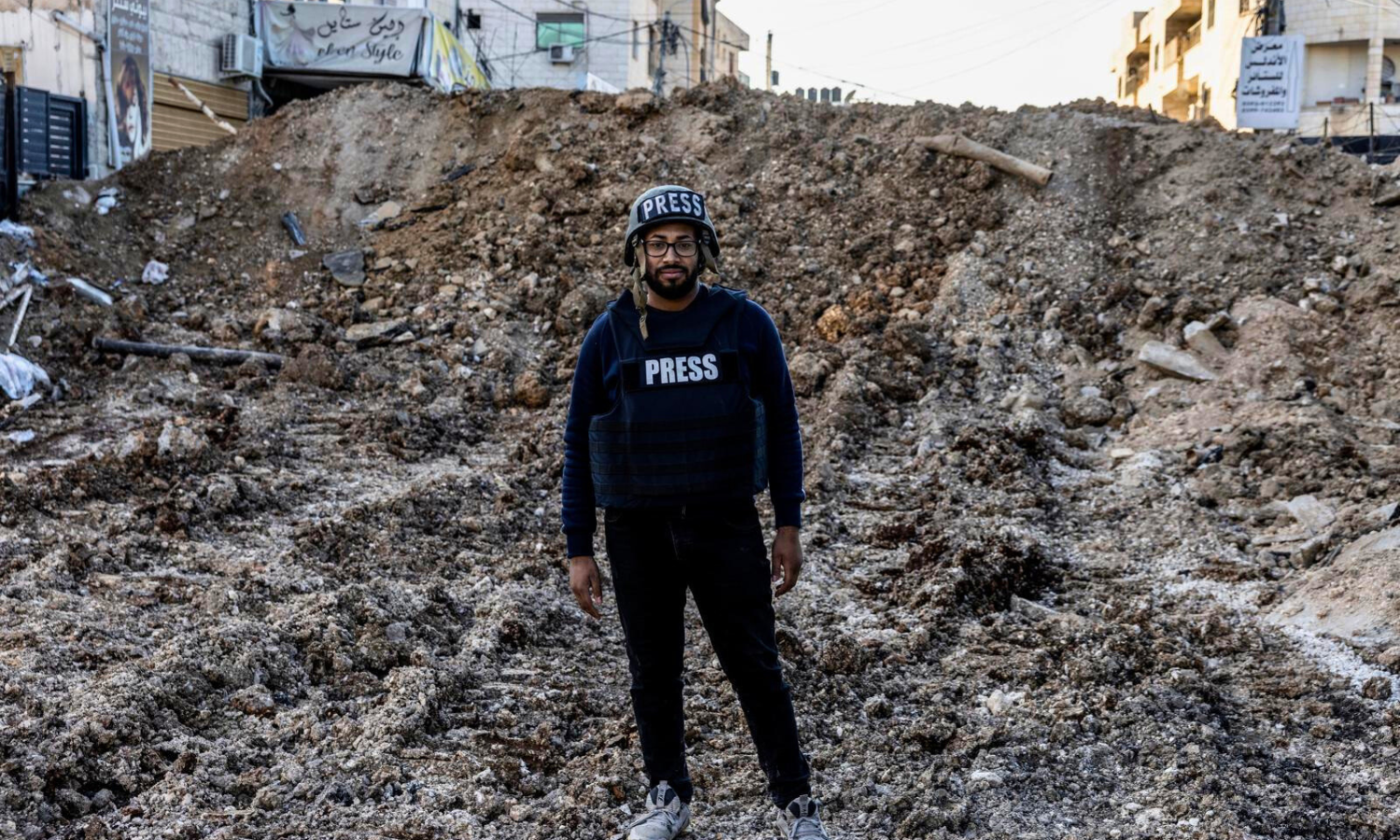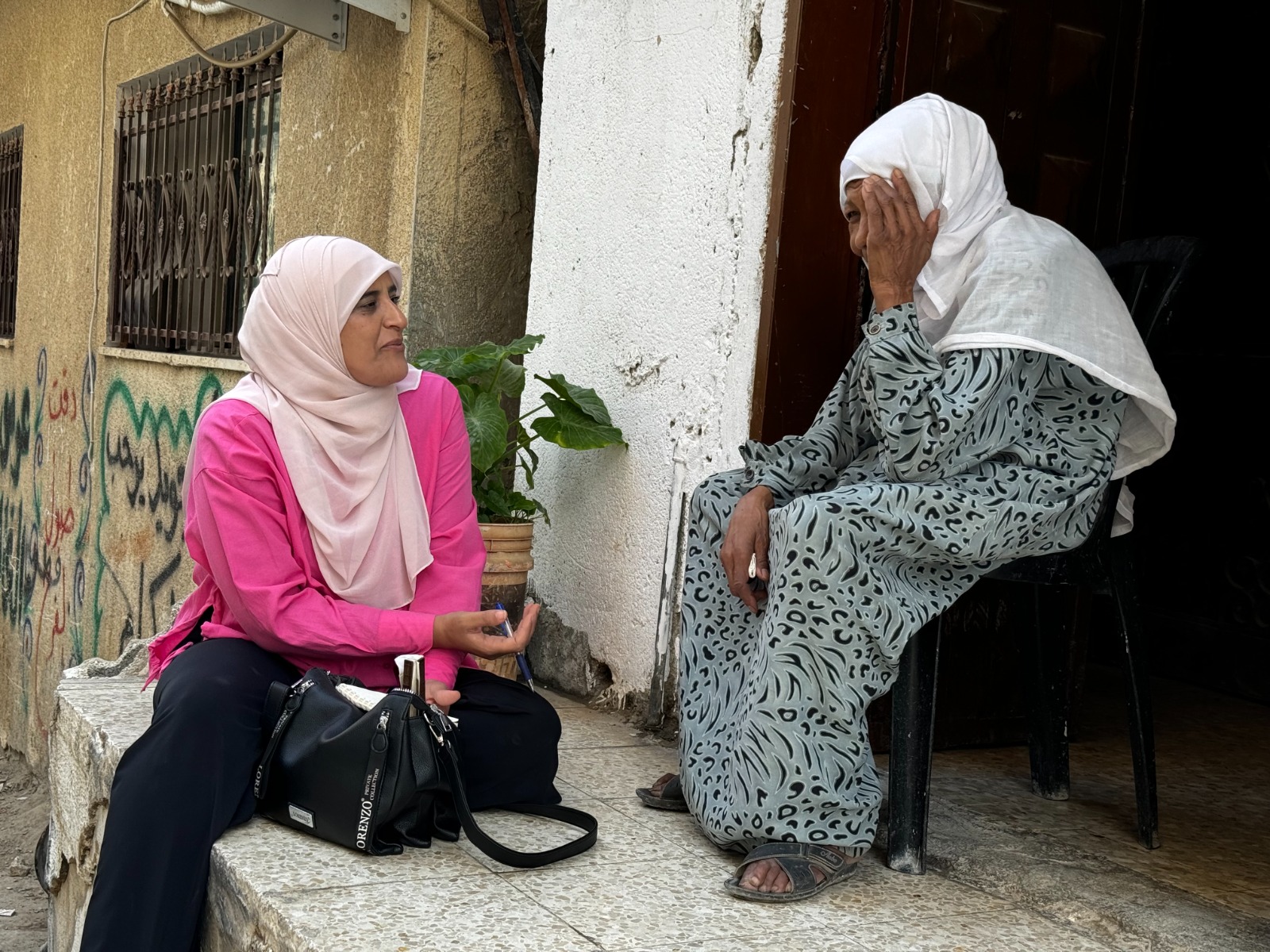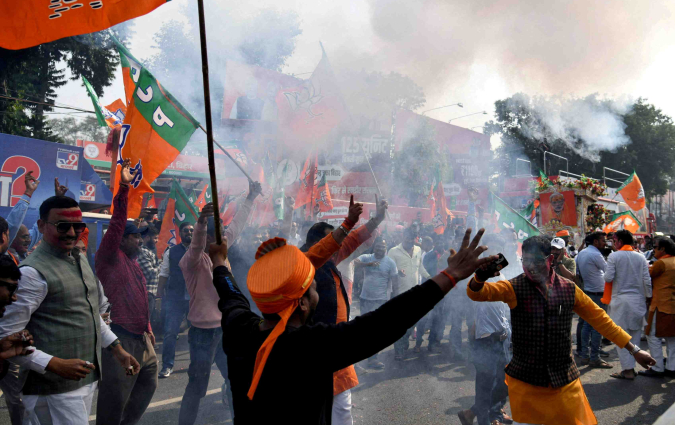As Gaza enters a new chapter, West Bank journalists speak out about the growing threats to their work and lives

Palestinian journalist Ismail H. I. Banighorra stands on a destroyed road in Jenin in the West Bank
During the Israeli Defence Force’s largest raid on the West Bank city of Ramallah, journalist Qassam Muaddi happened to be writing at a cafe in the city’s central square. He doesn’t always cover breaking news, but was there to witness the assault on 24 August that injured dozens through live rounds, rubber bullets and tear gas.
Muaddi, who writes for independent news outlet Mondoweiss, escaped with “just the smell of tear gas,” but this proximity to violence is not uncommon for many Palestinian journalists who live in the West Bank.
According to the UN, Israel has killed almost 1,000 Palestinians in the West Bank since October 2023, including 212 children. This repressive environment is taking its toll on journalists in the occupied territory and making it very difficult for reporters to do their job.
While witnessing their colleagues in Gaza being slaughtered on an unprecedented scale, West Bank journalists have suffered a military occupation, settlers attacking them with impunity and a suffocating system of checkpoints and restrictions that severely affect their ability to work.
I spoke to Muaddi and to three more Palestinian journalists in the territory about the challenging conditions in which they work while living under a system that the International Court of Justice and other global organisations have compared to South Africa’s apartheid.
In the firing line
From being shot in the chest to being awarded a BAFTA in London less than 12 months later, Ismail H. I. Banighorra’s experience exemplifies the standing of Palestinian journalists in the eyes of the world. Respected internationally for their work by some, they are Israeli authorities as a target and threat.
Banighorra is a documentary producer and received his award for Channel 4’s ‘State of Rage’, a film which explores the violence in the region. Banighorra is from Jenin, a refugee camp in the north of the West Bank. The town is home to residents (and their descendants) who fled their homes in what is now Israel in 1948, as Zionist militias enacted a military campaign that respected historians like the University of Oxford's Avi Shlaim have defined as ethnic cleansing.
Earlier this year, the Israeli army invaded Jenin and other nearby refugee camps, displacing 40,000 residents. Banighorra was one of them. Like other Palestinian journalists, he was prevented from covering these ongoing military operations. The army demolished Banighorra’s house as part of the incursion, and he now lives with his family in a house his family had built in a small village as a contingency plan.
In May 2024, during a previous incursion by the Israeli army, Banighorra was shot in the chest and hospitalised for 30 days. “I was going to work in the early morning when special forces deployed over a roof and started targeting people,” he said. Banighorra has supplied a photo of himself in hospital, covered in blood as a doctor treats him.
Two children, a doctor and a teacher were killed in the attack which killed seven.
The shooting left Banighorra with broken ribs and a hole in his lung as well as shrapnel which is still in his body. Ambulances sent to treat Banighorra were fired upon, according to video footage he shared.
“It was a tough moment for me, but I considered [myself] lucky to survive,” said Banighorra, who believes the IDF go after journalists in order to pressure them into silence. “If they see that you are a journalist, you will be a target because they want to cover up the truth.”
Palestinian journalist Aziza Nofal has worked as a freelance reporter since the start of her career in 2003. While covering the ongoing Israeli raids in Jenin for Al Jazeera, Nofal and her crew were also targeted by Israeli forces as they set up on the edge of the camp.
Ducking behind a car to evade what they thought were bullets, they realised a tear gas canister had instead landed beside them. On another occasion stun grenades were fired at her. While covering another Israeli raid in the Tulkarem refugee camp on a separate occasion, a bullet narrowly missed her. She thinks “it’s a miracle” that she and her crew have not been injured given the number of attacks they’ve gone through.
Navigating discrimination and privilege
Leila Warah, a freelance journalist and resident of the Aida refugee camp near Bethlehem, told me she has to navigate a multi-layered system of discrimination and privilege as she goes about her work.
Warah knows she can be targeted as a reporter and as a Palestinian, but is relatively advantaged “as someone with an American passport and who looks very white.” But working on assignments with other Palestinian colleagues means she has to be aware of how her actions can potentially put her colleagues at risk.
She recalls an incident where she was detained and interrogated for secretly filming long delays at a military checkpoint. After being released, the IDF soldiers focused their attention on her driver and accused him of allowing her to break the rules. “He could be put in prison without charges or trial for years. So deciding when to film is not only deciding on your own safety, but on the safety of those around you who have less privileges in this racist state,” she said.
Much of Banighorra work involves working alongside Western journalists. But this working relationship doesn’t always provide a shield from Israeli forces. “They shoot, they act, and then they actually look into who you are,” he told me about his interactions with the IDF.
As recently as late August, a Deutsche Welle team, including its senior international correspondent Fanny Facsar and freelance photojournalist Issam Rimawi, were threatened with weapons and fired upon with tear gas as they covered an Israeli raid in Ramallah.
A few months earlier, in late-May, Rimawi was assaulted after witnessing Israeli settlers launch an attack on Palestinian farmers whose crops were being burned. As he returned to his car, six settlers intercepted him and beat him unconscious. They also damaged and stole his equipment, and broke his fingers and wrists.
“I tried to show them I was a journalist, speaking in several languages, and used my cameras to shield myself. But they intensified the attack,” Rimawi told the Committee to Protect Journalists after the attack.
This is far from an isolated incident. In July, Israeli settlers attacked a CNN crew including journalist Jeremy Diamond while reporting on the murder of a Palestinian-American citizen in the town of Sinjil, suggesting that even mainstream, Western journalists are not always afforded protections from assault in the course of their work.
Reporting amid checkpoints
The scattering of checkpoints, gates and road closures throughout the West Bank makes any reporting assignment especially difficult. The mood of a soldier can make the difference between getting a day’s work done or not.
“Sometimes I receive denial of passage at some checkpoints. If they find out I am from Jenin, I might get in trouble,” said Banighorra citing the IDF’s suspicions of residents of a town known for its history of resistance to the occupation. Sometimes he has to turn down assignments in certain areas for fear of his own safety.
Muaddi has twice been stopped and interrogated by the IDF. On one of those occasions the vehicle he was in was pulled over and he was singled out among the passengers for carrying a camera.
“They put me in a stress position, on my knees with my arms behind my back for 30 minutes during which they took my camera. I don't know what he saw on the camera. But with the tip of his rifle, a soldier hit me really hard on my side and said, ‘Are you Hamas?’” Muaddi was released, but his memory card was confiscated.
The hostility towards Palestinians by Israeli settlers and soldiers becomes even starker when travelling through unfamiliar territory. This system of roads built for settlers and soldiers can become a deathtrap for Palestinians. Cars are clearly identifiable as Palestinian or Israeli by their white or yellow licence plates. So a wrong turn or a misdirection by a sat-nav can spell disaster.
Warah once had a settler pull a gun on her and her colleagues as they made a U-turn at an Israeli petrol station. “He started yelling at us to back up, and was pointing his gun at us, and flipping out, and we literally thought he was going to shoot us,” she told me.
The unpredictable nature of travelling by car is why Nofal prefers to take public transport for work. A bus also offers greater anonymity to passengers. “Soldiers won't pull over a bus and interview everybody, but they might do that to people travelling by car,” she said.

Planning ahead
Since Hamas’ attacks against Israel on 7 October 2023, the level of repression in the West Bank has become a lot worse. This has inevitably affected the working lives of the journalists I spoke to.
Nofal said: “It's very difficult to move from place to place.” Warah echoed this sentiment: “It’s gotten much harder, and it was very hard before. All of the risks that were there before are just times ten.”
The increasing unpredictability of travelling around the West Bank means journalists have to take additional steps to account. “I need to plan in advance if I want to go to Jenin when it’s literally two hours away,” said Muaddi. “You want to make sure that roads are open, that you’ll get there on time. There’s always a risk that you come face to face with the Israeli army while being in the field.”
Muaddi said he tries to keep as low a profile as possible and plans meticulously how long he will be in the field, who he’ll be meeting and what he hopes to get from his sources even if that means being inflexible or reducing opportunities to discover information by chance.
“Sometimes I already have a structure of the article that I’m going to write and that helps me to spend as little time [on location] as possible,” he told me.
For feature-length pieces, it’s not always possible to do a quick in-and-out reporting job, increasing the odds of being stuck on the wrong side of a closed checkpoint and unable to return home. On one occasion when this happened, he had to sleep in a derelict coffee shop. “I woke up to find seven people sleeping in the same place,” he explained.
Nofal also said she now prefers to sleep overnight in towns where she is reporting from to avoid lengthy travel delays.
Despite the potential for metaphorical and literal roadblocks, Warah said she always plans to complete a full day of work. “If you don’t plan to do anything, and there’s no checkpoint, and there’s no settler attack, and there’s no problems, you’d be like, ‘Oh, well, we could have just done everything today,’ right?”
Warah said that on the day after our interview, she was planning on visiting a school in the village of Khan al-Ahmar which has been threatened with destruction like many other West Bank communities. For a journey that could take as little as 45 minutes, she would plan to leave a full additional hour earlier.
The impact of Shireen Abu Akleh’s killing
The killing of veteran journalist Shireen Abu Akleh by the IDF in May 2022 sent shockwaves through much of the global journalism community and was felt viscerally throughout Palestine.
Abu Akleh had been covering an Israeli raid on Jenin and was wearing a helmet and body armour clearly identifying her as a journalist when she was shot in the head by an Israeli sniper.
For months, the IDF denied they had shot her, falsely blaming Palestinian militants. They later admitted it was one of their own, but no one has been held to account for this crime. Israel has rejected US calls for an investigation into the killing of Abu Akleh, who was a dual US-Palestinian citizen. Israeli police attacked mourners at her funeral in Jerusalem.
Prior to Abu Akleh’s killing, 30 journalists, mostly Palestinian, had been killed by the IDF since 2000 across all Palestinian territories. But her immense standing meant her death was painfully felt by Palestine's journalists and news audiences. Our own Journalist Fellow Haya Abushkhaidem cited her as one of the reasons she found her purpose as a journalist: “She was the brave voice that exposed to the world the horror stories of our life in Palestine. Her courage and composure filled us with a sense of serenity despite the chaos in which we lived.”
For some journalists, her killing represented a very personal threat. If she could be killed with impunity, anyone wearing a press vest could. “I really felt like the Israel army was looking down my eyes and our eyes, all of us, like, ‘you're next’,” Muaddi told me.
Freelancer Nofal said that her young daughter was actually relieved when she lost her work with Al Jazeera, after the broadcaster was closed by both Israel and the Palestinian Authority. “‘Alhamdulillah, Mum, Alhamdulillah. I hope they don’t open it,’” Nofal recalls her saying. “‘They will kill you as they did Shireen.’”
The journalists killed in Gaza
Within 18 months of Abu Akleh’s assassination, Palestine’s journalists began to suffer an even darker threat. Dozens of journalists were killed within weeks of the start of the genocide in Gaza in October 2023, according to the Committee to Protect Journalists. To date, the CPJ says 197 have been killed; as of September 2025, the UN estimated it was at least 248.
Learning that their professional colleagues are getting killed every day is taking a heavy toll on West Bank journalists. “It’s painful and unacceptable for the mind to take,” says Banighorra. Despite having been shot himself, he almost feels a sense of guilt for his relative degree of comfort: “I look at myself and [the fact] I live a pretty satisfied life, while they don’t have the opportunity to live as I do.”
Speaking of Israel's ‘double-tap’ strike on Gaza’s Nasser Hospital 25 August 2025 in which five reporters were killed, Muaddi said he was especially upset about the death of Mohammad Salama, a 24-year-old photojournalist. “I really related to him, because he had a tough way into the profession, but he was passionate. I admired him a lot, and when he got killed, I was like, ‘No, it can’t be him.’”
To add insult to injury, Palestinian journalists say Gaza’s reporters have often been let down by the lack of support from Western news organisations and the way they often report claims from Israel that turn out to be false. A recent example happened after the same Nasser Hospital bombing when the IDF claimed it was targeting a ‘Hamas camera’. Several reputable news sites reported this version uncritically. An investigation from Reuters, which first reported the claim and whose own journalist Hussam al-Masri was killed in the attack, later found Israel’s claims to be false.
Beyond the bullets
In the violent context described in this piece, Muaddi regrets the way that Palestinians in the West Bank are often largely reduced to the subjects of news flashes, particularly concerning violent eruptions. “In order to exist for the rest of the world, you need to die or kill,” he said, a framing which eliminates the humanity of people in the territory.
Reversing this process of dehumanisation has become even more important in the past couple of years. Nofal shares the same frustration, saying her interest in covering climate change (she is a member of the Reuters Institute’s Oxford Climate Journalism Network) is largely overlooked by news outlets’ preference for covering conflict.
So how can journalists move beyond the stereotypes of Palestinians as either victims or militants while still acknowledging the brutality of life under military occupation? “It's important to re-humanise Palestinians, to focus more on the human experience, which includes their memory, their culture, everything,” says Muaddi.
He told me that during one period in 2022 he covered the killing of at least one Palestinian each day for 10 consecutive days. But rather than seeing them only as victims, he “tried to go to the family and [understand] who that person was. What did they like? What were their dreams?”
He explained he tries to understand the longer term impact of the incidents that end up in the headlines we see on the other side of the world. “The real story, for me, begins afterwards,” he said, noting that when a house is demolished, local media tend to take the same quotes and photos and move on. Muaddi is more interested in how communities will cope going forward. “Where are they going to sleep? How are they going to manage their things?” he said
In every email we send you'll find original reporting, evidence-based insights, online seminars and readings curated from 100s of sources - all in 5 minutes.
- Twice a week
- More than 20,000 people receive it
- Unsubscribe any time






